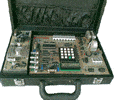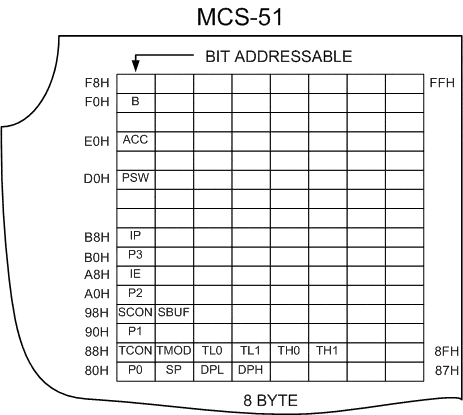

Microcontroller Kits
Programmer and Target 89s51![]()
Simple Mikrokontroller 89s51 Trainer
Standart
Mikrokontroller 89s51 Trainer![]()
Super Mikrokontroller Trainer 89s51
All Item Include
1.2. Special Function Register
A Map of the on-chip memory area called the Special Function Register (SFR) space is shown in Figure 1.2.1. Note that in the SFRs not all of the addresses are occupied. Unoccupied addresses are not implemented on the chip. Read accesses to these addresses will in general return random data, and write accesses will have no effect. User software should not write 1s to these unimplemented locations, since they may be used in other 80C51 Family derivative products to invoke new features. The functions of the SFRs are described in the text that follows.

Figure 1.2.1. MCS-51 SFR Memory Map
Accumulator
ACC is the Accumulator register. The mnemonics for Accumulator-Specific instructions, however, refer to the Accumulator simply as A.
B Register
The B register is used during multiply and divide operations. For other instructions it can be treated as another scratch pad register.
Program Status Word
The PSW register contains program status information as detailed in Tabel 1.2.1
Stack Pointer
The Stack Pointer register is 8 bits wide. It is incremented before data is stored during PUSH and CALL executions. While the stack may reside anywhere in on-chip RAM, the Stack Pointer is initialized to 07H after a reset. This causes the stack to begin at locations 08H.
Data Pointer
The Data Pointer (DPTR) consists of a high byte (DPH) and a low byte (DPL). Its intended function is to hold a 16-bit address. It may be manipulated as a 16-bit register or as two independent 8-bit registers.
Ports 0 to 3
P0, P1, P2, and P3 are the SFR latches of Ports 0, 1, 2, and 3, respectively. Writing a one to a bit of a port SFR (P0, P1, P2, or P3) causes the corresponding port output pin to switch high. Writing a zero causes the port output pin to switch low. When used as an input, the external state of a port pin will be held in the port SFR (i.e., if the external state of a pin is low, the corresponding port SFR bit will contain a 0; if it is high, the bit will contain a 1).
Serial Data Buffer
The Serial Buffer is actually two separate registers, a transmit buffer and a receive buffer. When data is moved to SBUF, it goes to the transmit buffer and is held for serial transmission. (Moving a byte to SBUF is what initiates the transmission.) When data is moved from SBUF, it comes from the receive buffer.
Timer Registers
Register pairs (TH0, TL0), and (TH1, TL1) are the 16-bit Counting registers for Timer/Counters 0 and 1, respectively.
Control Register
Special Function Registers IP, IE, TMOD, TCON, SCON, and PCON contain control and status bits for the interrupt system, the Timer/Counters, and the serial port. They are described in later sections.
Table 1.2.1 Program Status Word
|
MSB |
LSB |
||||||
|
CY |
AC |
F0 |
RS1 |
RS0 |
OV |
|
BIT |
SYMBOL |
FUNCTION |
|
PSW.7 |
CY |
Carry flag. |
|
PSW.6 |
AC |
Auxilliary Carry flag. (For BCD operations.) |
|
PSW.5 |
F0 |
Flag 0. (Available to the user for general purposes.) |
|
PSW.4 |
RS1 |
Register bank select control bit 1. |
|
PSW.3 |
RS0 |
Register bank select control bit 0. |
|
PSW.2 |
OV |
Overflow flag. |
|
PSW.1 |
User-definable flag. | |
|
PSW.0 |
Parity flag. |
Program Status Word
The Program Status Word (PSW) contains several status bits that reflect the current state of the CPU. The PSW, shown in Figure 10, resides in the SFR space. It contains the Carry bit, the Auxiliary Carry (for BCD operations), the two register bank select bits, the Overflow flag, a Parity bit, and two user-definable status flags. The Carry bit, other than serving the function of a Carry bit in arithmetic operations, also serves as the “Accumulator” for a number of Boolean operations. The bits RS0 and RS1 are used to select one of the four register banks shown in Figure 1.7. A number of instructions refer to these RAM locations as R0 through R7. The selection of which of the four is being referred to is made on the basis of the RS0 and RS1 at execution time.
The Parity bit reflects the number of 1s in the Accumulator: P = 1 if the Accumulator contains an odd number of 1s, and P = 0 if the Accumulator contains an even number of 1s. Thus the number of 1s in the Accumulator plus P is always even. Two bits in the PSW are uncommitted and may be used as general purpose status flags.
Comments, questions and discussion about this topic